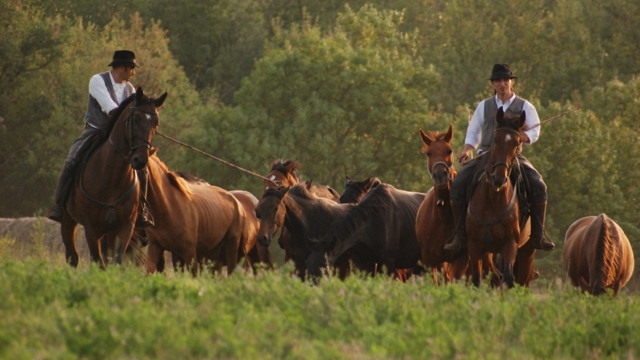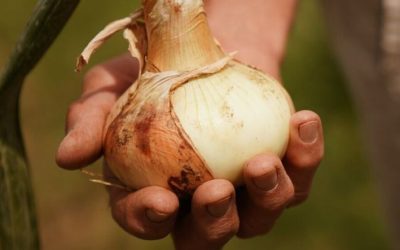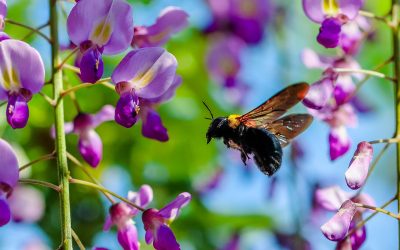 di Nadia Fondelli – È un mestiere epico avvolto in un alone di magia che ancora sopravvive in Toscana.
di Nadia Fondelli – È un mestiere epico avvolto in un alone di magia che ancora sopravvive in Toscana.
È il Buttero simbolo della Maremma. Per conoscere meglio questa figura, la sua storia e il suo lavoro, abbiamo incontrato Stefano Senserini, direttore tecnico dell’Associazione Butteri d’Alta Maremma, noto come “Sensibile”, perché ogni buttero che si rispetti ha un suo soprannome…
Chi è stato nella tradizione e chi è oggi il buttero?
Il mandriano, colui che era preposto alla sorveglianza, alla cura, alla doma e all’addestramento dei grandi branchi di vacche e cavalli allevati allo stato brado.
Purtroppo le opere di bonifica, degli anni Trenta e Quaranta del Novecento, e la riforma agraria, degli anni Cinquanta, che ha segnato il passaggio dal latifondo alla mezzadria, hanno quasi fatto sparire la figura del buttero.
L’allevamento brado è quasi scomparso e con se si è portato via usi e costumi che hanno da sempre caratterizzato questa terra. I pochi butteri esistenti oggi si trovano in aziende statali o regionali che mantengono questo tipo di allevamento, più per tradizione che per tornaconto economico.
Essere butteri oggi è quindi più una passione che un lavoro?
Oggi è per pochissimi un lavoro e per molti solo un atto d’amore per questa terra meravigliosa e per i nostri nonni per i quali essere buttero era un onore, era elevarsi dalla massa e anche se era pur sempre un lavoro umile era ambito e ammirato.
La passione di chi oggi veste questi panni è quindi quella di mantenere vive queste tradizioni, di evitare che vadano dimenticate e perse per sempre.
Buttero e Maremma binomio imprescindibile?
Sicuramente sì. Buttero e Maremma sono legati a doppio filo; sicuramente senza la Maremma non sarebbe esistito il buttero, ma è anche vero che nel corso dei secoli il buttero è diventato il simbolo di questa terra divenendo quasi un personaggio dall’alone eroico e rappresentando la Maremma in giro per il mondo.
Ci spiega una volta per tutte la differenza fra il cowboy e il buttero?
In senso stretto, non c’è molta differenza tra il buttero e il cowboy, come non ce n’è con il Gaucho argentino. Sono tutte persone che svolgono il medesimo lavoro. La sola grande differenza è che il buttero ha origini antichissime, dato che esisteva molto prima che Cristoforo Colombo scoprisse l’America e quindi quello che a noi da più fastidio è sentir dire che noi siamo i cowboy italiani. Semmai è il contrario, sono loro a essere i butteri americani!
Qual era il lavoro del Buttero?
Semplificando possiamo dire che la sua vita non era semplice; lavorava ogni giorno a cavallo a contatto con gli animali con qualunque tempo, controllando oltre 500 capi di vacche e tori maremmani bradi e 120 cavalli!
La sua giornata iniziava quando ancora era buio e sceglieva uno dei 3 o 4 cavalli che aveva a disposizione, in virtù delle mansioni da svolgere nella giornata.
A maggio, nella seconda quindicina, quando gli animali hanno perso il pelo invernale, veniva effettuata “la merca”, cioè la marchiatura a fuoco dei capi di bestiame, una vera e propria cerimonia che richiamava gente alla fattoria, segnava l’entrata ufficiale dei vitelli e dei puledri giovani nella mandria e costituiva per il buttero l’occasione di dimostrare la sua abilità.
Con fatica e incitamenti, e l’aiuto di lunghi bastoni, le mandrie venivano guidate verso un recinto e da qui ogni animale veniva separato dal gruppo (sbrancato) e indirizzato verso il tondino (recinto circolare) per la marchiatura, dove, dopo esser stato immobilizzato, tre uomini “lo marchiavano” col fuoco: uno per l’anno di nascita, uno per il numero progressivo dell’animale (impressi ai lati della groppa) e infine con il simbolo dell’allevamento (visibile sulla coscia).
Va considerato che il vitello maremmano a un anno è già sviluppato, agile e forte per la vita libera che ha condotto e dentro il tondino è estremamente nervoso per essere stato separato dal gruppo e per la vicinanza degli uomini.
Atterrarlo e impastoiarlo è una lotta pericolosa e infatti da qui il detto: “Chi va alla merca e non è mercato, alla merca non c’è stato”, cioè chi va a fare la marchiatura e non si fa nemmeno un graffio vuol dire che alla marchiatura non c’è stato…
La Transumanza è ancora viva in questa parte d’Italia? La racconti…
È la forma più antica utilizzata per spostare il bestiame da un pascolo esaurito a uno migliore.
Esistevano due tipi di transumanza: quello delle greggi di pecore, che d’autunno scendevano per svernare in Maremma, un immenso fiume di lana che calava verso il mare dall’Appennino tosco-emiliano e da quello alle spalle di Arezzo.
Poi c’era la transumanza dei cavalli, detta “estatura” che come dice la parola avveniva in estate per sfuggire alla malaria.
La nostra associazione ogni anno rievoca la transumanza, spostando un branco di cavalli bradi lungo un percorso che attraversa, nel volgere di due giorni, il meraviglioso paesaggio della Maremma Toscana.
È quindi possibile fare la transumanza con voi?
Certo, chiunque possieda un cavallo potrà vivere un’esperienza fantastica, e troverà la sera pasti caldi della cucina tipica maremmana, musica, balli e una allegra compagnia per poter rivivere antiche atmosfere.
La vostra associazione vuole far conoscere il mestiere e le attività del buttero. Quali gli appuntamenti da non perdere….
Durante l’anno svolgiamo spettacoli nelle più importanti fiere equestri italiane e in feste in tutta Italia.
Gli spettacoli equestri sono il nostro fiore all’occhiello con cui cerchiamo di far conoscere le qualità del cavallo maremmano, e consistono in esibizioni di antichi giochi tipici della Maremma, come il “Gioco della Rosa” e lo spettacolare “Carosello”, una coreografia di figure eseguite al trotto e al galoppo in un susseguirsi di cavalli e cavalieri che formano un tutt’uno con la musica che li accompagna in cerchi, pettini, diagonali mozzafiato.
Qui si vede l’abilità del buttero, ma anche le qualità del cavallo Maremmano che si fida ciecamente del suo cavaliere e lo asseconda anche nella più pericolosa delle figure.
Durante il periodo estivo inoltre, nelle nostre strutture del Puntone di Scarlino, abbiamo appuntamenti fissi in notturna (agosto) nei quali oltre a presentare i numeri sopradescritti diamo anche dimostrazione di quello che era il lavoro del buttero, conducendo una mandria di vacche maremmane nel recinto e facendo vedere come si spostano e si dividono i vitelli durante la merca.
A fine settembre organizziamo la Transumanza delle Colline Metallifere, che quest’anno ha celebrato la sua XVIII edizione, e parteciperanno, con i propri cavalli, cavalieri da tutta Italia aiutandoci a spostare un branco di puledri bradi; e, infine, un’altra attività di cui andiamo fieri è quella di gestire insieme alle Bandite di Scarlino l’allevamento allo stato brado di una mandria di vacche Maremmane nel Padule di Scarlino.
Info: www.butteri-altamaremma.com – email: info@butteri-altamaremma.com
 di Nadia Fondelli – Shrouded by an aura of magic, it is an epic trade that still survives in Tuscany. The “Buttero” is the symbol of Maremma. To learn more about this figure, its history and its trade, we met with Stefano Senserini, technical manager of the Associazione Butteri d’Alta Maremma (association of Butteri of the Upper Maremma), also known as “Sensitive”, because every “buttero Online Pokies” worthy of the title has a nickname.
di Nadia Fondelli – Shrouded by an aura of magic, it is an epic trade that still survives in Tuscany. The “Buttero” is the symbol of Maremma. To learn more about this figure, its history and its trade, we met with Stefano Senserini, technical manager of the Associazione Butteri d’Alta Maremma (association of Butteri of the Upper Maremma), also known as “Sensitive”, because every “buttero Online Pokies” worthy of the title has a nickname.
Who was the “buttero” traditionally and who is he today?
The “buttero” is the herdsman, the person who was traditionally in charge of watching over, looking after, taming and breaking large herds of cows and horses bred in the wild.
Sadly, the land reclamation works carried out in the 1930s and ‘40s, and the agrarian reform of the 1950s, which marked the transition from the large landed estates to sharecropping, almost caused the extinction of the “buttero”.
Wild breeding has almost disappeared, eradicating in its wake customs and traditions that have always distinguished this land. The few remaining “butteri” can be found in state or regional companies, which preserve this type of breeding more for traditional reasons than economic interests.
So, being a “buttero” today is therefore more of a passion than a job?
Today, very few “butteri” consider their craft a profession. For the majority, it is an act of love towards this wonderful land and our grandparents, for whom being a “buttero” was an honour, a means to rise above the masses and a much coveted and admired profession, albeit a humble one.
Today, those who carry on this trade, are motivated by the desire to keep these traditions alive, to save them from being forgotten and lost forever.
So, the words “buttero” and Maremma are inseparable?
Yes, without a doubt. “Buttero” and Maremma are two closely related concepts; the “buttero” would never have existed without the Maremma region, but it is also true that, over the centuries, the “buttero” has become the symbol of this land, virtually taking on an air of heroism and representing Maremma around the world.
Can you explain, once and for all, the differences between the cowboy and the “buttero”?
Strictly speaking, there are few differences between the two, just as the “buttero” does not differ much from the Argentinian Gaucho. They all do the same job.
The only major difference is that the “buttero” dates much further back, given that the figure existed way before Christopher Columbus’s discovery of America, so what annoys us the most is that we are called the Italian cowboys. It’s the exact opposite: cowboys are the American “butteri”!
What did the Buttero’s duties involve?
To put it simply, the life of the “buttero” was not an easy one; his duties involved watching over more than 500 wild Maremma cows and bulls and 120 horses every day, sitting atop a horse come rain or shine.
His working day started when it was still dark and he chose one of the 3 or 4 horses available, according to the tasks to be performed during the day. In May, during the second half of the month, when the animals shed their winter coats, the “merca”, that is, the branding of the cattle heads, was carried out.
This was a veritable ceremony, which attracted people to the farm, signalled the official entry of the young calves and foals into the herd and offered the “buttero” the opportunity to display his skills.
With much effort and spurring, and with the aid of long sticks, the herds were guided towards an enclosure and from here each animal was separated from the group (cut out) and directed towards the tondino (circular fence) to be branded. After being immobilized here, the animal was branded by three different men: one branded the year of birth, another the animal’s serial number (marked at either side of the rump) and a third the farm’s symbol (visible on the thigh).
One must bear in mind that a one year-old Maremma calf is already fully developed, possesses strength and agility owing to the free life it has led, and, inside the tondino, is extremely nervous because it has been separated from the group and is surrounded by people.
The struggle to floor and fetter the calf is an dangerous one, hence the saying: “Chi va alla merca e non è mercato, alla merca non c’è stato”, that is, he who takes part in the branding and comes out of it without a single scratch didn’t perform it in the first place…
Does transhumance still exist in this part of Italy? Can you explain what it means?
It is the oldest method used to move the cattle from a depleted grazing land to a fresh pasture. There were two types of transhumance: one was the transhumance of sheep flocks, which descended in the autumn to winter in Maremma; an endless sea of wool marching towards the sea from the Tuscan-Emilian Apennines and the Apennines north of Arezzo.
The second was the transhumance of horses, known as estatura, which, as the word suggests in Italian, took place during the summer season to avoid malaria. Every year our association recreates the experience of transhumance, moving a herd of wild horses along a course that cuts across the glorious landscape of the Tuscan Maremma over a two-day period.
Can people take part in the transhumance experience with you?
Of course. Anyone who owns a horse will be able to enjoy an extraordinary experience, with hot and typical, local dishes in the evenings, as well as music, dances, all in the company of cheerful people recreating ancient atmospheres.
Your association aims to spread the word about the trade and duties of the “buttero”. Which events should we not miss out on?
During the year we organise equestrian shows at leading Italian equestrian fairs and at shows all around the country.
The equestrian shows are the feather in our cap: they are an opportunity for us to display the Maremma horses’ qualities and consist of ancient games, typical of the region, such as the “Game of the Rose” and the spectacular “Carousel”, a choreography of trotting and galloping movements, where horses and horsemen follow one another forming a whole with the music accompanying them as they perform breathtaking circles, serpentines and diagonals.
It is during such performances that the skills of the “buttero” and the Maremma horses are displayed to their fullest, the horse trusting its rider so blindingly as to tackle even the most dangerous of movements.
Furthermore, during the summer season, in our Puntone di Scarlino complex, we hold set evening events (on August), featuring, in addition to the aforementioned performances, a demonstration of the “buttero’s” duties: the buttero leads a herd of Maremma cows into an enclosure and shows the public how the calves are arranged and separated during the branding phase.
From end September onwards, we organise the Colline Metallifere Transhumance, this year are celebrateed 18th year.
The event will attract riders and their horses from all over Italy and they will help us move a herd of wild foals. Last but not least, we are also proud to be co-managing, with the Bandite di Scarlino, the wild breeding of a herd of Maremma cows in the Padule di Scarlino area.
For further information contact: www.butteri-altamaremma.com – e-mail: info@butteri-altamaremma.com




0 commenti